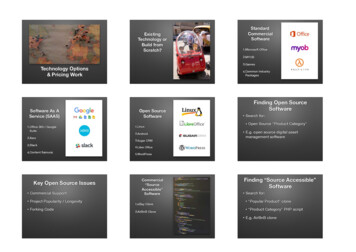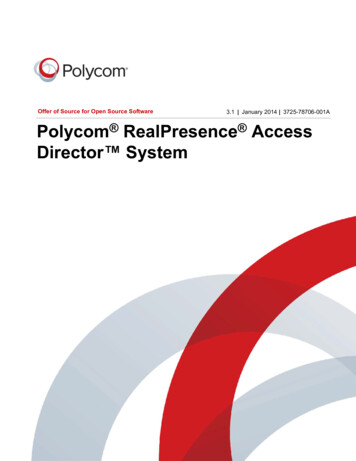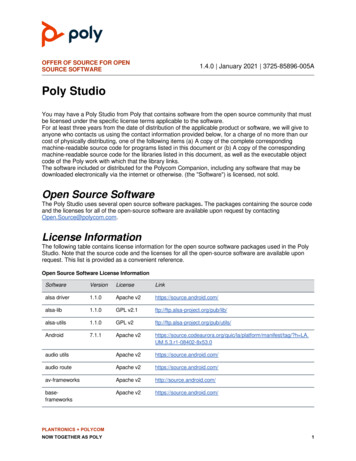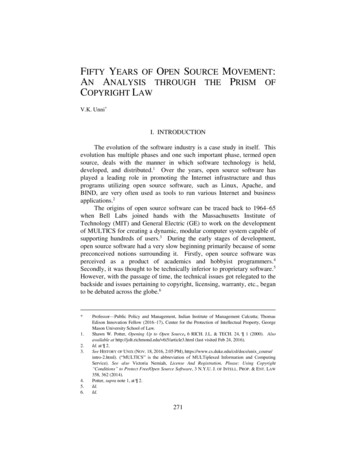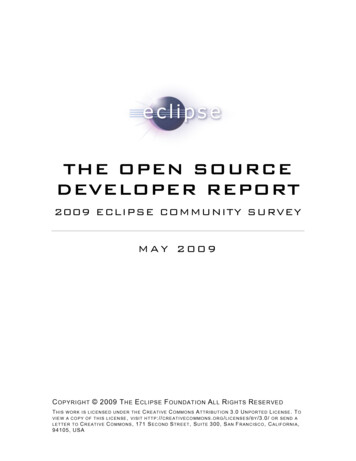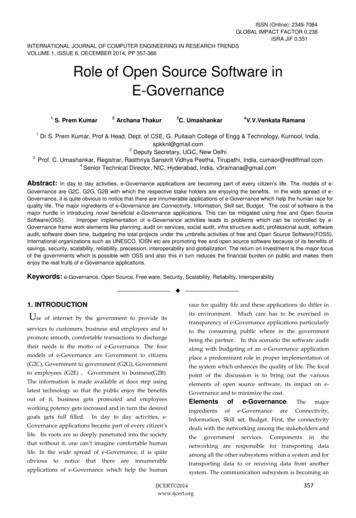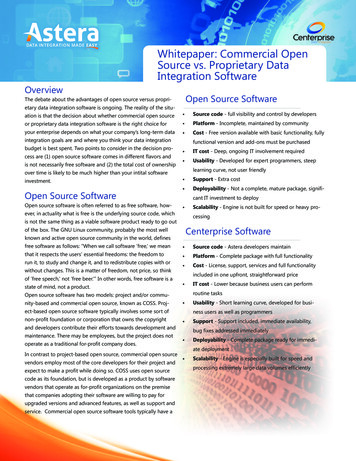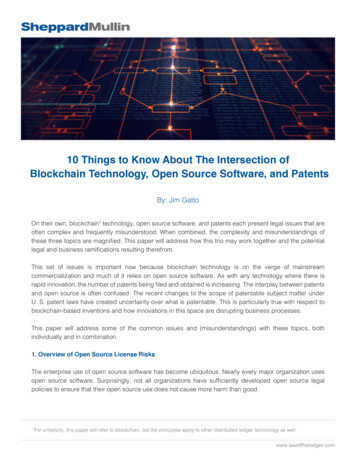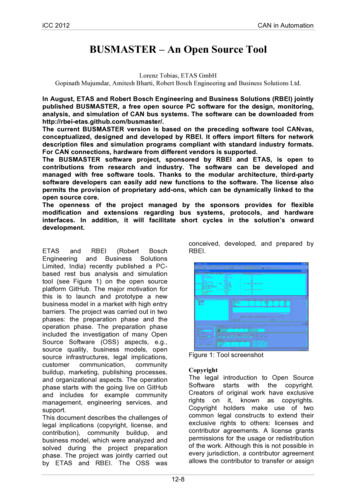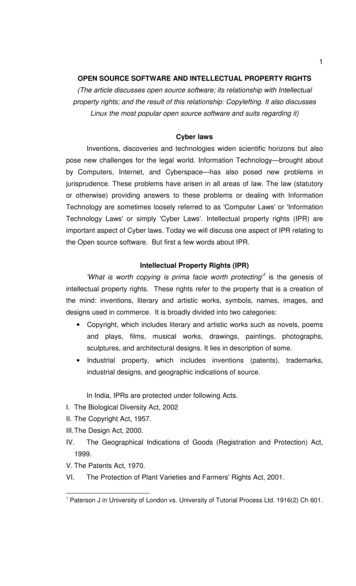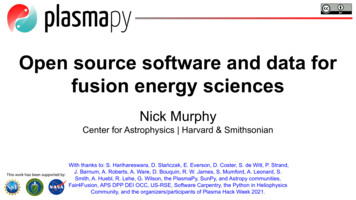
Transcription
Open source software and data forfusion energy sciencesNick MurphyCenter for Astrophysics Harvard & SmithsonianThis work has been supported by:With thanks to: S. Harihareswara, D. Stańczak, E. Everson, D. Coster, S. de Witt, P. Strand,J. Barnum, A. Roberts, A. Ware, D. Bouquin, R. W. James, S. Mumford, A. Leonard, S.Smith, A. Huebl, R. Lehe, G. Wilson, the PlasmaPy, SunPy, and Astropy communities,Fair4Fusion, APS DPP DEI OCC, US-RSE, Software Carpentry, the Python in HeliophysicsCommunity, and the organizers/participants of Plasma Hack Week 2021.
My background Graduate school in astronomy (U. Wisconsin) Studied connections between laboratory & astrophysical plasmaphysics Postdoc and researcher (Center for Astrophysics) Studied solar physics and fundamental plasma science Last 3.1 0.7 (3σ) years Research software engineering for PlasmaPy Advocating for open & reproducible plasma science Most recent pandemic hobby Reading tokamak data management plans
Main point for the next 71 minutesThe fusion energy sciences community does not yet havea culture that supports open sharing of software and data.But we will!
Topics for the next 70 minutes Data and software environment comparison Solar physics Fusion energy sciences Open science Motivation Barriers FAIR principles for data stewardship Example: Fair4Fusion Open source software Example: PlasmaPy
Case study: solar physics Similarities with fusion energy sciences Plasma physics is foundational Diagnostics (e.g., spectroscopy) Comparisons between simulations and reality Differences with fusion energy sciences Solar observations are more homogeneous Images, spectra, and time series No experimental control “There’s only one Sun.” — D. Coster
The solar physics software environment SolarSoft Community-developed (unclear licensing)Developed since the 1990sWritten in IDL (proprietary language)Monolithic architecture SunPy Community-developed (open source license)Developed since 2011Written in Python (open source language)Modular architectureWritten using modern software engineering best practices
The solar physics data environment Most observational data sets are openly available The Virtual Solar Observatory (VSO) allows us to: Simultaneously search multiple databases Download data from multiple observatories Multiple ways to use VSO Web interface SolarSoft SunPy Data sets are mostly standardized
Can start downloading solar data in minutes
Consequences for solar physics Data sets are widely used and re-used Multiple groups can study the same event Customary to use data from multiple sources Data sets well-suited for machine learning studies Well-documented and well-tested community software Less software duplication Data access not restricted by major institutions
Fusion energy sciences data environment Access to most experimental data is restricted Can often request permission User agreements often contain restrictions such as: No commercial use (without prior approval) No redistribution of data (without prior approval) Internal approval required for presentations & papers Data sets usually not standardized Difficult to search archives
Fusion energy sciences software environment Dependence on legacy codes Often not open source Different degrees of documentation, testing, and usability Software and many data sets bridged together by OMFIT Likely to become open source soon! Common license customizations Restrictions on commercial use Limits on redistribution rights Difficult to find out which codes do what
Consequences for fusion energy sciences Hard to find data Cannot simultaneously search across tokamak data archives Hard to access data Need to request permissions Difficult to perform cross-device studies Hard to write analysis software for multiple devices Need partially met by OMFIT Reduced scientific reproducibility
Increasing number of open source software projects PlasmaPyOMFIT (soon!)OMAStofuPyMethesFIDASIMAurorasimsopt BOUT MOOSE
Open science principles Open access data Open source software Open methodology Open peer review Open access publications Open educational resources
Open science principles Open access data Open source software Open methodology Open peer review Open access publications Open educational resources
Why open science? Reduce barriers to access Broaden research impact Improve scientific reproducibility Make research more transparent Make publicly funded research available to the public Maximize use of data Allow community review of results Invest in our future
Barriers to open science Pressure to publish Fear of being scooped Time pressure Financial pressure Open access publication often costs extra Bureaucracy and institutional inertia Decisions might need approval of ITER Council Power imbalances Early career scientists more likely to support open science
Barriers to open science Toxic culture Blatant or subtle acts of racism, sexism, etc. Bullying, harassment, and discrimination Retaliation Equity gaps Language barriers Scientific information sometimes only available in English National security and intellectual property rights
Academic reward system What’s good for science what’s good for scientists Good for career New and exciting results Not “wasting time” making data & software available Good for science Writing software documentation Investing time to make data & software available How can we make what’s good for science also what’s goodfor scientists?
Open science is an investment It takes time and resources to: Make data FAIRWrite documentationWrite testsMaintain softwareLearn necessary skills Open science will not happen right away .but it is worth the effort!
How do we get closer open science? Change our culture Ensure psychological safety Eliminate equity gaps Change our institutions Collaborate on technical infrastructure Open access data Open source software
How do we get closer to open science? Change our culture Ensure psychological safety Eliminate equity gaps Change our institutions Collaborate on technical infrastructure Open access data Open source software
The FAIR principles for data stewardship Findability Accessibility Interoperability Reusability
Findability Before being able to reuse a data set we have to find it! Assign digital resources a persistent identifier Digital Object Identifiers (DOIs) Describe data sets with rich metadata Index data sets in a searchable resource Zenodo online repository operated by CERN Virtual Solar Observatory
Accessibility Can access a data set using its persistent identifier Can access metadata even if original data set is gone Accessible is not the same as open Authentication and authorization sometimes required
Data should be openly available when possible Data sets from most fusion devices are not openly available Should each device create its own online open archive? Possible duplication of effort Potential limitations on cross-device searchability Could we create a community-wide portal to access openfusion/plasma data sets? Improve findability, accessibility, & reproducibility Enable cross-device studies Allow wide re-use of data
Some data from MAST is now openMAST Mega Ampere Spherical Tokamak
Some data from MAST is now open
Interoperability Fusion facilities often have their own way of storing andorganizing data Hard to perform cross-device studies Hard to develop shared software Approach #1: develop software to serve as an interface OMFIT bridges different data types and software packages Approach #2: adopt shared standards for data
Why do we need data interoperability? Suppose we are doing experiments at two facilities Basic Plasma Science Facility (BaPSF) Wisconsin Plasma Physics Laboratory (WiPPL) We’re studying the same physical process but data from BaPSF & WiPPL are structured differently! We need to write separate software to perform the sameanalysis A common data model would enable shared software andpromote cross-device collaborations Examples: IMAS, Plasma-MDS, OpenPMD, SPASE, MetaSat
Plasma science needs open metadata standards A metadata standard describes an agreed-upon way tostructure and understand data A meaning is assigned to each variable name Reduces ambiguity Greatly improves interoperability Allows different groups to use and interpret data Metadata crosswalks convert between different standards
Why should metadata standards be open? Some standards like IMAS (for ITER) are not open Open standards allow for wider adoption PDF, Blu-Ray, etc. Restricting access to metadata standards limits adoption May lead to creation of competing standards
Reusability Describe data with sufficient metadata Metadata meet community standards Data sets have a clear license Data sets include detailed provenance Where did the data come from?
Benefits of reusable data Broaden access to research data Maximize knowledge gained from data sets Improve scientific reproducibility Enable machine learning studies
Fair4Fusion Objective: Make European-funded fusion data more widelyavailable & FAIR Raise awareness of open data within the fusion program Develop tools needed for an open data approach Lay foundations for an open data policy Subset of tasks Outreach to communityDefine use casesCreate blueprint architecture for open fusion dataBuild data foundation for open accessDevelop open data demonstratorshttps://www.fair4fusion.eu/
Fair4FusionFair4Fusion is laying the groundwork to improve the data environment for fusion
Use cases from F4F show need for open access As a member of the general public, I would like to know howmany shots per day and per year are performed by each ofthe experiments. As a researcher, I want to locate all H-mode shots that hada flat-top phase of longer than 0.5 seconds, across aselection of devices. As a data provider, I want to ensure the appropriateavailability of my data without breaking the law (e.g. GDPR).Adapted from D. Coster et al., doi: 10.5281/zenodo.4337222, CC BY 4.0
Efforts to make fusion data FAIR need to continue The Fair4Fusion project ends later this year All deliverables to be completed on schedule Lesson: It’s very difficult to change an established communitywith “working” practices.but the astronomical and meteorologicalcommunities show it can be done. Significant potential for international collaboration As with International Heliophysics Data Environment Alliance
Open Source Definition Software is open source if anyone is free to use, modify,and/or redistribute it Including source code An open source license does not discriminate againstpersons, groups, or fields of endeavor No restrictions on commercial use The Open Source Initiative maintains a list of approved licenses Customizing licenses causes problems
Two categories of licenses Permissive licenses have few restrictions Examples: MIT and BSD 2-clause license Copyleft licenses require derived works to be releasedunder the same license Example: GNU General Public License version 3 (GPLv3) Two licenses are compatible if they allow both programs tobe combined into a single program Permissive licenses maximize license compatibility
Pain points with scientific software Lack of user-friendlinessDifficult to compile & installInadequate documentationUnreadable codeCryptic error messagesLicensing issuesPackages not written to work with each otherUnvalidated code
Consequences of pain points Beginning research is hard Collaboration is difficult Duplication of functionality Research is less reproducible Research can be frustrating
How can we address these pain points? Make our software open source Write readable, usable, & maintainable code Use a high-level language, where appropriate Prioritize documentation Create an automated test suite Develop code as a community Build a shared software framework.A software ecosystem!
What is PlasmaPy?MissionTo grow an open source software ecosystemfor plasma research & education
Many ways to be part of the community Come to PlasmaPy’s. Community meeting (Tuesdays at 18 UTC) Office hours (Thursdays at 18 UTC) Join our Element chat Request new features on GitHub Organize community events Contribute!
Current & planned PlasmaPy subpackagesplasmapy.particles Object-oriented representations of ions, electrons, andfundamental particlesplasmapy.formulary Commonly needed formulae for plasma parameters andtransport coefficientsplasmapy.simulation To include building blocks of plasma simulations and animproved particle tracker46
Current & planned PlasmaPy subpackagesplasmapy.analysis Analysis techniques for data from simulations, experiments, andobservationsplasmapy.diagnostics For representations of plasma diagnostics such as Langmuirand magnetic flux probes, as well as synthetic diagnosticsplasmapy.dispersion To contain dispersion relation solvers for plasma waves47
Current & planned PlasmaPy subpackagesplasmapy.plasma Base classes to represent different plasmasplasmapy.utils Helpful tools for the rest of the packageplasmapy.addons Entry point for affiliated packages to be put in PlasmaPynamespace48
Biggest challenges for PlasmaPy Changing the culture Community-wide software development Building community Supporting new contributors Lack of a community-wide portal for experimental data Lack of open metadata standards
Plasma Hack Week 2021 (28 June – 2 July) Mix of a summer school and a hackathon Tutorials for research software engineering How to contribute to open source projects Writing clean scientific code Testing scientific software Tutorials for different plasma packages PlasmaPy, OMFIT, BOUT , Gkeyll, etc. Videos to be posted online soon Expected to be annual event
The nascent field of research software engineering Research software engineers (RSEs) include Researchers who spend most of their time programming Software engineers developing scientific software Everyone in between The term “research software engineer” was coined in 2012 Problems Unclear career paths for RSEs Insufficient training for scientists to become RSEs University courses on research software engineering?
Building a healthy and innovative workforce
Psychological safety is necessary for open science Members of the plasma community should be able to: Be their authentic selves; Share their perspectives and make mistakes; Without fear of bullying, retribution, or discrimination Psychological safety is foundational for diversity, equity, andinclusion Diversity, equity, and inclusion are foundational for openscienceReference: Beyond Buzzwords and Bystanders: A Framework for Systematically Developing a Diverse, Mission Ready, and InnovativeCoast Guard Workforce by K. Young-McLear, S. Zelmanowitz, R. W. James, D. Brunswick, & T. W. DeNucci.
Codes of conduct All collaborative software projects need a code of conduct Describe unacceptable behaviors (e.g., harassment) Promote positive behaviors (e.g., demonstrating empathy) Each code of conduct should have an enforcement policy Example: Contributor Covenant Code of Conduct
Summary Fusion energy & plasma sciences are becoming more open Open science requires cultural change, institutional change,and technical infrastructure Scientific data should be findable, accessible, interoperable,and reusable Work has begun on an open source software ecosystem forplasma research and education
Open Source Definition Software is open source if anyone is free to use, modify, and/or redistribute it Including source code An open source license does not discriminate against persons, groups, or fields of endeavor No restrictions on commercial use The Open Source Initiative maintains a list of approved licenses

